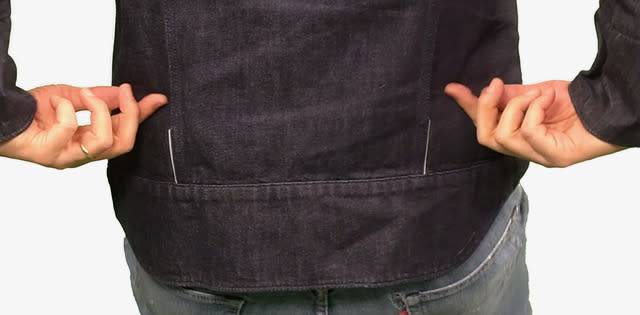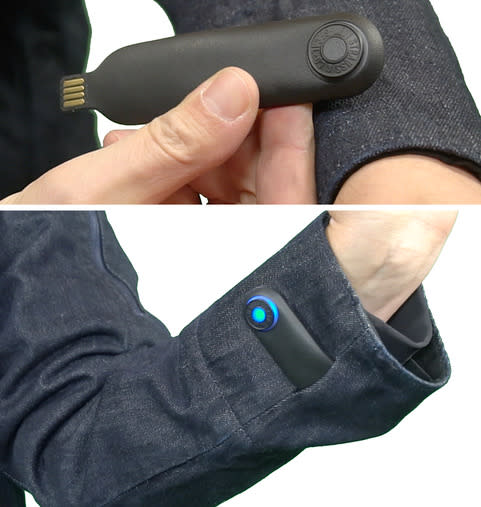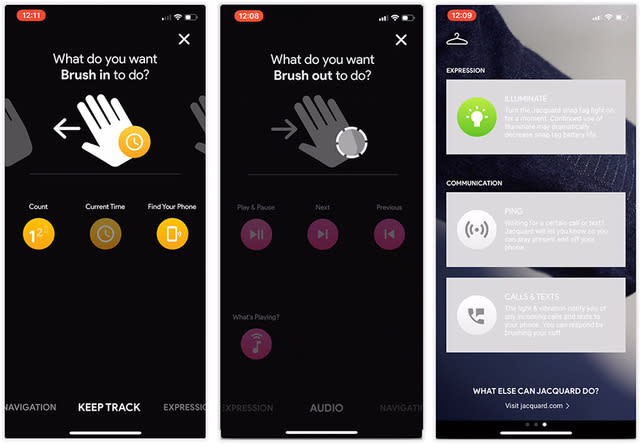Google and Levi's created a digital jean jacket. Here's what I think of it
Google has been designing physical goods for years now. But once you’ve come out with your own lines of phones, laptops, speakers, VR goggles, earbuds, and cameras, what’s left?
Clothing.
Yes, Google has teamed up with Levi’s to create the ultimate wearable technology: A great-looking, nosebleed-priced jean jacket ($350). It bears the nearly infinite name, “Commuter Trucker Jacket with Jacquard by Google.”
The CTJWJBG is targeted at a super niche audience: bike riders whose hands are on the handlebars and not their phones.

The handsome blue denim CTJWJBG looks like Levi’s traditional trucker jean jackets, with a few important differences:
Extra pockets in convenient places for your phone, sunglasses, whatever. In addition to the two snap-closed breast pockets and the two regular hip-mounted slash pockets, there’s also a zippered one on the outside left upper arm, as well as a zippered inside breast pocket.

Reflective details on the back, to help you stand out when you’re on the road at night.
Extra back panel to cover your waistband when you’re leaning forward on your bike, to avoid presenting the world with Biker’s Butt.

A little slit to hold the snap tag. More on this in a moment.
The biggest difference, though, is hidden. On the top surface of the left cuff, Levi’s has woven a grid of conductive, touch-sensitive thread, developed by Google just for this purpose. In essence, it turns your left cuff into a trackpad for simple taps and gestures — yet the jacket remains flexible and, more important, washable. (Levi’s says that the CTJWJBG is the first washable wearable in history.)

Clearly, a trackcuff (cuffpad?) is going to need power and circuitry. So Google has also developed an impressively thin, flexible, five-inch rubberized strap that it calls the snap tag. It contains the battery, Bluetooth, vibration module, LED light, and all the silicon. When you need to charge the tag (or wash the jacket), you just yank it off. One end fits into any computer’s USB jack for charging, and a charge easily lasts two weeks. You can put the snap tag back onto the jacket with one hand: One end slips into a little slit in the cuff; the other end snaps easily to the cuff.

The functions
Once you’ve downloaded the Jacquard app for Android or iPhone, and paired the snap tag with your phone, the fun begins.
By reaching across with your right hand, you can make any of four gestures on the trackcuff: Double-tap, swipe upward (away from your hand), swipe downward, or cover the cuff completely.
Using the app, you define what each of those gestures means (well, the swipes and taps, anyway; covering the cuff always means “silence all”). Here are your options:
Play/pause music. This trick, like most of the jacket’s stunts, assumes that you’re wearing earbuds and they’re connected to your phone.
Next track/previous track.
Identify this song. You hear the song name and artist spoken in your earbuds.
Next GPS instruction. For example, “Turn right on Maple Street in two miles.”
“You will arrive in 20 minutes.”
Speak the time.
Speak the incoming text message.
Find Your Phone. Makes your phone start ringing with a special chime, as long as it’s within about 30 feet of the jacket.
Count. Weird but neat: every time you make this gesture, the jacket increments a running tally. You can use it to count patrons coming into the bar, or number of F-bombs in a comedian’s speech, or birds you’re spotting—anything you like.
Illuminate. Lights up the LED on the left cuff button.

In addition to these customized gestures, double-tapping always means “answer this call” (or “hang up this call”). When you’re pedaling along and a call comes in, your wrist buzzes, the left snap lights up, and, when you double-tap your left wrist, you can take the call.
And covering up the entire cuff always means, “Hold everything.” Music pauses, phone calls are quiet.
All of these gestures work flawlessly. I mean, the jacket and phone respond instantaneously and effortlessly, every single time. That part, Google and Levi’s have truly nailed.
But remember: You get to choose only three of those gestures! If you’ve set up the swiping to mean next track/previous track, and double-tapping to mean play/pause, then you can’t use any of the GPS, Find Phone, Count, or Illuminate functions (at least, not without firing up the app and changing the settings).
That limitation means that the CTJWJBG is one very expensive three-trick pony.
It’s not even the only pony on the block. You can already control your music playback with the switch on your earbuds cord — no jacket needed. And if you have speech-enabled wireless earbuds, like Apple’s Airpods or Google’s Pixel Buds (half the price of the jacket), you can do all of that stuff by voice. In that regard, the jacket feels like a juicy, but somewhat redundant, luxury.
The future
Google and Levi’s are well aware of the success/failure they’ve got on their hands. “This is a pilot product, not the final realization” of the idea, a product manager told me.
Already, since the jacket’s introduction last fall, Google has added new features to the app, and Levi’s, for its part, says it’s very interested in pursuing this concept. “Right now, we have a touch sensor, but we could add more sensors: temperature sensor, heating plates, motion sensors —everything is possible. This jacket is a first step,” says the Levi’s rep.
He also pointed out, by the way, that, “for the first time in the history of apparel, we have an insight on how it’s being used. We’re getting an indication of which gestures, which features people use the most.”
Yes, that’s right: This jacket collects data about you. What did you expect from a Google product?
(The companies stress that this data is aggregated and anonymized — they’re not tracking you, only all jacket buyers as a group.)
A non-digital Levi’s Trucker Jacket usually costs $90 (in fact, they’re $70 at the moment). So adding the Google part more than triples the price.
Clearly, at that price, not many people will buy this jacket, and they shouldn’t. But that’s fine with Google and Levi’s. Their goal wasn’t to crank out a bestseller; it was to develop a trial balloon, to take a first step into our digital-clothing future. And in that regard, it’s safe to say that the CTJWJBG experiment is a beautifully designed, flawlessly operating success.
David Pogue, tech columnist for Yahoo Finance, welcomes non-toxic comments in the Comments below. On the Web, he’s davidpogue.com. On Twitter, he’s @pogue. On email, he’s [email protected]. You can sign up to get his stuff by email, here.
Read more
Google Clips uses AI to snap pictures of your kids and pets — sort of
Why I bought Honda’s plug-in hybrid mystery car
Look up! A dozen ‘air taxi’ flying cars are readying for takeoff
